At Cotswold Koi we supply a wide range of Pond Fluid Bed Media. With our extensive range of products we have tried to cater for everyone.
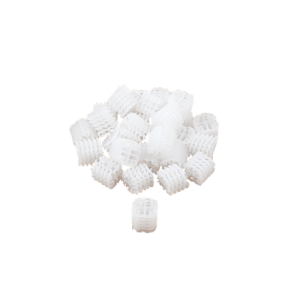
Bio Carrier Hel-X
Bio Carrier Hel-X
This type of media is kept moving via aeration in the filter; the so-called moving bed. This is often used in combination with a drum filter. It also provides excellent performance when used with a trickle filter.
Air-Aqua offers this media in three different diameters: 13 and 17 mm. The smaller the diameter, the greater the media surface area per m3.
13 mm -> 300,000 pieces/m3 -> 767 m2/m3
17 mm -> 150,000 pieces/m3 -> 595 m2/m3
This is available in 100 litre bags
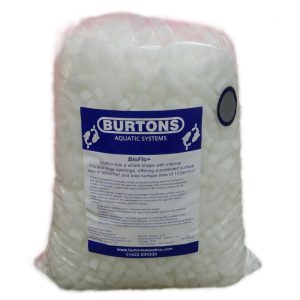
Burtons Bio Flo Media
Burtons Bio Flo Media
Bioflo+ is a wheel shaped media with internal fins and large openings, offering a protected surface area of 800m²/m³.
Bioflo+ is designed to provide a large protected surface area for the biofilm and optimal conditions for the bacteria culture when the media are suspended in water. A durable, rugged and highly efficient media for moving bed biological Filters.
Its innovative design creates a high percentage of protected surface area for micro-organisms to adhere. In turn, this increases the overall biomass concentration. Large openings allow for the wastewater to freely pass through the media which helps maintain a healthy and thin biofilm.
Features:
- Large active surface area, compact and low weight.
- Durable, long life and perfect for use in all aquatic systems with minimal clogging.
- Excellent replacement with easy upgrade for existing filter media in both internal and external filters to dramatically increase filter capacity when used in aquariums.
- Corrosion resistant material suitable for both Mechanical and biological filtration.
- Designed to provide maximum protected surface area for bacteria to colonise
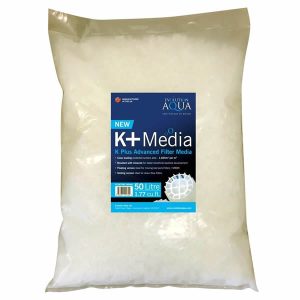
K+ Filter Media
K+ Filter Media
New advanced filtration media
Plastic media, for use in biological pond filters – specifically in moving bed bio reactors, was pioneered by Evolution Aqua, some 20 years ago. In recent years, other plastic media have come onto the market, usually with the aim of trying to get more and more surface area. However, one drawback to using plastic media has always been the time it takes to establish a stable biofilm – essential for good filtration.
After many years of research, Evolution Aqua have now developed a new media that not only gives class leading surface area, but also overcomes the problem of long maturation times.
Class leading surface area
K+ Filter Media is designed and manufactured in the UK by Evolution Aqua. This advanced media, with its innovative design, and class leading surface area provides enhanced biological and mechanical filtration.
As Evolution Aqua extrude K+ Media, Minerals and Enzymes are added to the raw material. The result of this process, unique to Evolution Aqua, is a filtration media that not only out performs most of it’s competitors due to its large protected surface area, but also answers the problem of how to speed up the time taken to mature your filter.
Minerals added for faster filter maturation
During the extrusion process, Evolution Aqua add a range of minerals, along with magnesium, calcium, enzymes and salt to the raw material that is used to manufacture K+Media. The result means that K+Media will mature much faster than many other types of media.
- The addition of these minerals creates a rough surface on the media. This textured surface has a microscopic honeycomb of peaks and craters that allow waste particles to collect, and nitrifying bacteria to form.
- The minerals act as a food source for the bacteria, helping the bacteria to develop and multiply at a faster rate, further improving maturation times.
- Calcium alone has proven advantages for developing and maintaining effective bio-films.
- The enzymes that are added also help to make the media “sticky” so waste particles can adhere to media easier.
- Salt is added during the extrusion process, which is dissolved during the cooling process, leaving a rough surface on which bio-film can easily adhere.
Increased surface area
With a new shape and profile, K+ Filter Media has also been designed to have an increased and class leading surface area, meaning an overall surface area of 1,350m2 per m3. More importantly for biological filtration, the protected surface area of K+ Media is 1,025m2 per m3. This allows a stable bio-film to form and remain intact when used in moving bed biological filtration, as in the new Nexus+.
Stable bio-film development
The shape of K+ Filter Media optimises the amount of “quiet zones” within the media where a stable bio-film can develop. Whilst K+Media keeps the integral profile of K1 Media at its core, there is an extra layer of cells and fins around the outside of each piece that enable microscopic organisms such as Rotifers and Vorticella to thrive. This is an additional benefit as competitor media do not have such “quiet zones” that would allow these higher lifeforms of filter feeders to develop. The bacteria and organisms that form within the bio-film ensure the media delivers optimum levels of biological filtration in the moving bed, which has been proven filtration technology for many years in the fishkeeping hobby.
Evolution Aqua also recommend using K+ Media in combination with the PURE Pond and PURE+ Filter Start Gel to boost bacteria levels which in turn will stick to the media and speed up the maturation process even more.
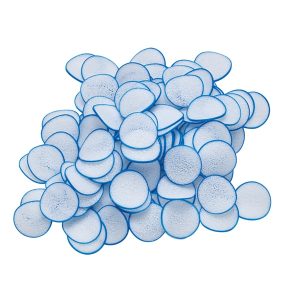
Oase Pond Pads
Oase Pond Pads
Oase Pond Pads provide an extremely effective bio-filter media featuring an innovative surface and pore structure. This high-performance Oase Pond Pads filter medium has been used in industry and waste water technology and further-developed by Oase to be optimised especially for use in filter systems for koi ponds, swim ponds and garden ponds. Thanks to Oase Pond Pads extremely large surface area Oase Pond Pads can be used perfectly in a moving bed process.
Oase Pond Pads used within a moving bed system provide a maintenance-free, self-cleaning filter medium. The Oase Pond Pads will achieve a neutral floating behaviour after approx. 6-10 week run-in time depending on water temperature and load.
Thanks to their large surface for the settlement of micro-organisms (Approx. 5000m² per m³) Oase Pond Pads will remove ammonia NH3/ammonium NH4 and nitrite NO2 via nitrification with 10L of media having the the capacity to decompose approximately 200g of fish food in a 24 hour period.
Oase Pond Pads Description:
- Highly effective bio-filter media
- Perfect for moving bed filter systems
- Can also be used in addition to existing moving bed filter media
- Extremely large surface area for micro-organisms (Approx. 5000m² per m³)
- 10L of media breaks down approx 200g of food in 24hrs
- Available in 20ltrs
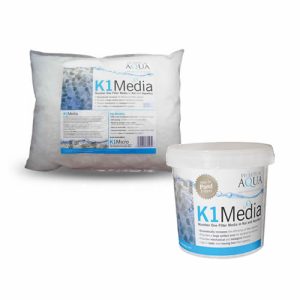
Kaldnes K1 Media
Kaldnes K1 Media
Kaldnes Moving Bed process, which has been scientifically tried and tested in fish farming and waste water treatment for over 10 years, is now available for fish keepers and is exclusively distributed worldwide by Evolution Aqua. The media is engineered in a wheel shape and is slightly positively buoyant. This allows a small amount of water flow to circulate the media throughout the vessel. This flow is created with your air pump and air stones or diffuser etc.
How it works : Maturing the Kaldnes bio-media is important because a delicate eco-system is naturally developing for the bacteria involved in the nitrification process. Kaldnes media provides the maximum active surface area for the bacteria to colonise, more than other types of static media. It is this process which removes harmful ammonia and nitrite from the water.
How it is different to other media : As the Kaldnes media moves within the filter, it causes the old dead bacteria on the outside to be displaced. This makes space for new younger heavier feeding bacteria to rapidly colonise. Within the wheel is a protected surface which enables colonies of bacteria to naturally follow their lifecycle, of maturing, dying and then fuelling the latter stages of the nitrification cycle. Kaldnes has been designed to provide the best possible habitat for both young and mature beneficial bacterial colonies.
Incorporating Kaldnes Moving Bed™ Process. Developed by Professor Halvard Odergard at Trondheim University of Science and Technology the Kaldnes Moving Bed™ bio film process has been designed specifically to create the most effective environment for the nitrification process to take place. The media is engineered in a wheel shape and is slightly positively buoyant, allowing a small amount of water flow (created by adding air to the process) to circulate the media throughout the vessel.
Oxygen and food (ammonia and nitrite) gives the bacteria the means to grow, whilst the Kaldnes media provides maximum surface area for the bacteria to colonise and produce bio film. It is this process, which removes harmful ammonia and nitrite from the water. As the Kaldnes media chaotically circulates within the bio tank, it causes old dead bacteria/bio film on the outside, to be removed making space for new younger heavier feeding bacteria/bio films to colonise. Within the wheel, is a protected surface, which enables colonies of bacteria to naturally follow their life cycle, maturing and dying, in turn fuelling the latter stages of the nitrification conversion process. It also assists in the breakdown of any small particles passing through from the mechanical stage. Therefore, the Kaldnes media maintains both a young bio film and a maturing bio film providing a more consistent filter performance, whilst improving water quality, encouraging healthier Koi and aiding in reducing green water and blanket weed.
Due to chaotic movement of the Kaldnes K1 media, the process is self-cleaning and requires no maintenance. This allows the filter to reach optimum effectiveness without the disturbance of periodic maintenance, avoiding unnecessary loss of bacteria within the filter preventing high levels of ammonia and nitrite within the water.
This amazing bio media which is reputed to be 10 times more efficient than matting and lowers Nitrate! 100 litres can process 1/2 kilo of high protein food per day! Designed to be moving at all times, Kaldnes K1 is self cleaning, owing to its continual motion in both water and airflows and is also therefore massively oxygenated thus rendering it super efficient. Kaldnes has also proven to be a fantastic static media to improve mechanical filtration as it does not block, but is capable of removing very fine solids and is very easy to clean
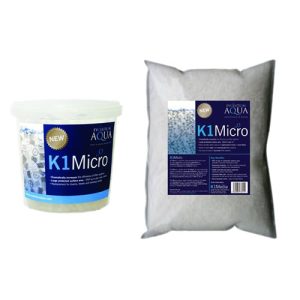
Kaldnes K1 Micro Filter Media
K1 Micro Filter Media
K1 Micro Filter Media is specifically designed for use in bead filters, conventional pond filters and aquarium filters. K1 Micro has the same wheel shaped design as K1 Media, but it has an increased protected surface area of 950 m2 per m3.
The wheel shaped structure of K1 Micro is designed specifically to create the most effective environment for the nitrification process to take place. As K1 Micro media matures, bacteria colonises in the “quiet areas” of each piece of media helping to improve nitrification / de-nitrification. This enables a well-balanced biological equilibrium to be sustained in your pond to keep fish healthy and the water crystal clear.
The small size of K1 Micro makes it ideal to be used a replacement for beads in a bead filter. Not only will the vast 950m2 per m3 protected surface area maintain a bio-film that helps to improve nitrification, water quality and clarity, but K1 Micro can offer many more benefits:
Increased protection for the bio-film. K1 Micro retains the bio-film within its wheel shaped structure.
Improved solids handling. A static bed of K1 Micro packs tightly together with areas for solid particles and fines to be captured, helping to reduce TDS levels.
Increased flow rate.K1 Micro allows enough water to flow evenly through media rather than tracking around a “clump” of beads. This means that flow rates are improved when using “like for like” pumps.
Reduced back pressure. The improved flow also reduces the back pressure or resistance inflicted on the pump. In turn this improves the pumps’ efficiency and may even result in the need for a lower rated pump which will ultimately save you money!
Improved cleaning. During a cleaning process, the bio-film remains protected within the K1 Micro.
Semi buoyant media. K1 Micro is a semi buoyant media which makes it ideal for a bead filter.
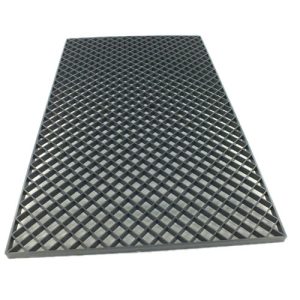
Media Grids
Media Grids
A most useful aid for anyone building their own filtration system these can be placed at a level that provides a void of water underneath the media itself and keeps the media out of any debris that may have gathered in the filter.
It supports the media and is quite robust and is a must really can be fixed together and cut to size using simply a fine toothed wood saw or angle grinder.
Size:
- 27″ x 16″
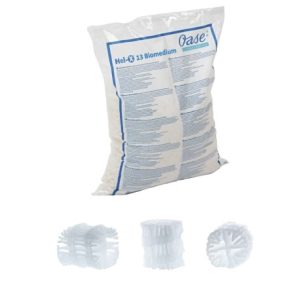
Oase Hel-X 13 Bio Media
Oase Hel-X 13
Following rigorous Research & Development, OASE Engineers in Germany have successfully re-developed the Oase Hel-X Bio Media to further increase its biological settlement surface area by an additional 13%, resulting in the launch of Oase Hel-X 13 Biomedium. Oase Hel-X 13 consists of individual housings which allow beneficial aerobic bacteria to settle and breed inside the protected casings, helping to biologically break down soluble waste within the OASE ProfiClear Premium Moving Bed Filter Modules.
Oase Hel-X 13 allows a greater amount of bacteria to be contained within the same filter volume, resulting in more rapid breakdown of food and fish waste within the filter system. 25 Litres of Oase Hel-X 13 Biomedia now has the capacity to biologically break down 170g of food/day.
Oase Hel-X 13 can be used on any Filters to significantly increase their biological capacity but has been specifically designed for the OASE Pond Filters .
Quantity: 25 Litres
